Wound Management in Palliative Care: A Professional Development Report
VerifiedAdded on 2023/06/18
|11
|2308
|129
Report
AI Summary
This report provides a comprehensive overview of wound management within palliative care, emphasizing the importance of addressing suffering and enhancing the quality of life for patients facing life-threatening illnesses. It identifies wound management as a critical issue, highlighting the need for nurses to effectively manage infections, pain, and overall well-being. The report delves into the principles of palliative care, including affirming life, relieving pain, integrating psychological and spiritual aspects, and offering support to patients and families. It explores both pharmacological (steroid inflammatory drugs, analgesia) and non-pharmacological (distraction, proper dressing, acupuncture) therapeutic interventions for wound management, alongside ethical considerations such as patient autonomy, beneficence, non-maleficence, and justice. The report concludes that a combination of pharmacological and non-pharmacological therapies, guided by ethical principles, is essential for effective palliative wound care.
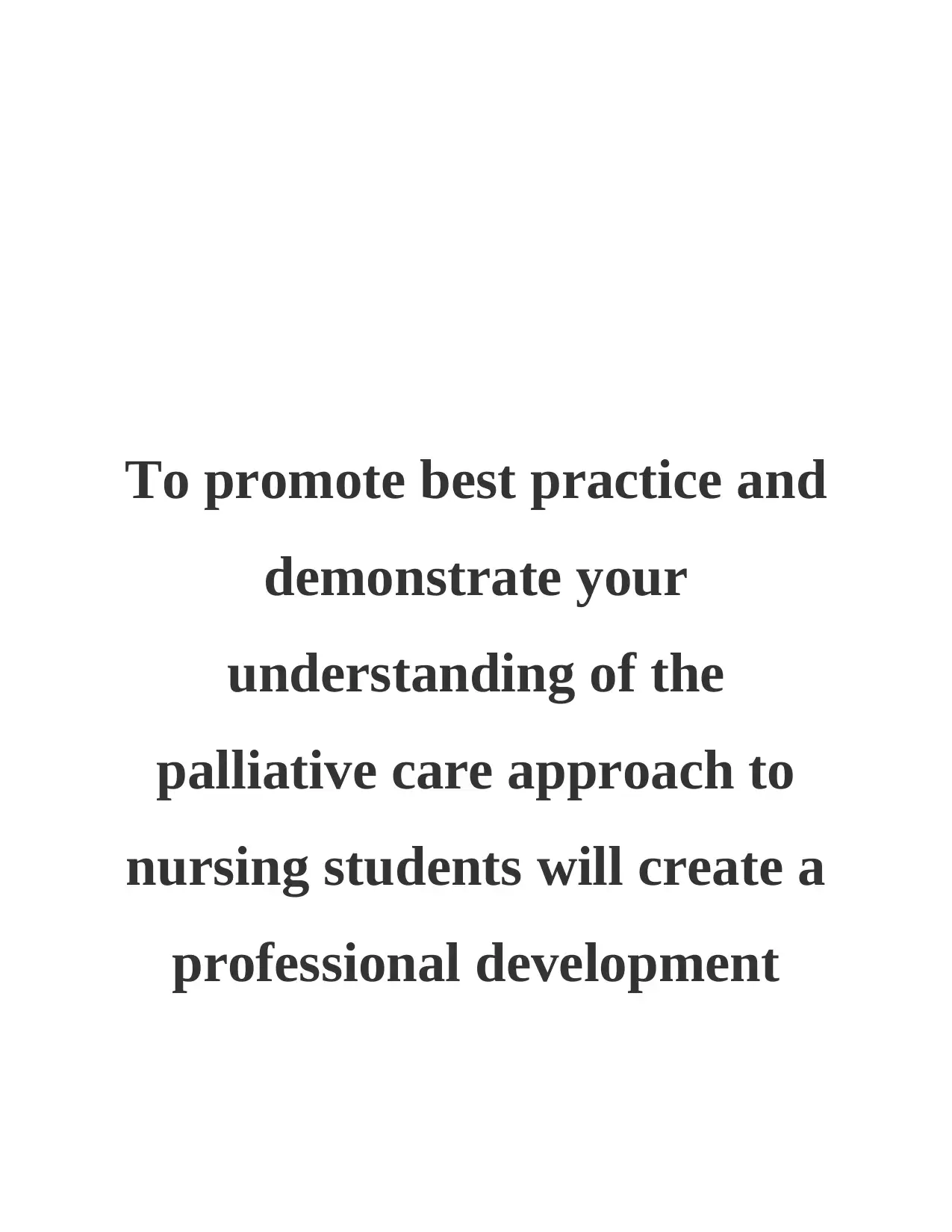
To promote best practice and
demonstrate your
understanding of the
palliative care approach to
nursing students will create a
professional development
demonstrate your
understanding of the
palliative care approach to
nursing students will create a
professional development
Paraphrase This Document
Need a fresh take? Get an instant paraphrase of this document with our AI Paraphraser

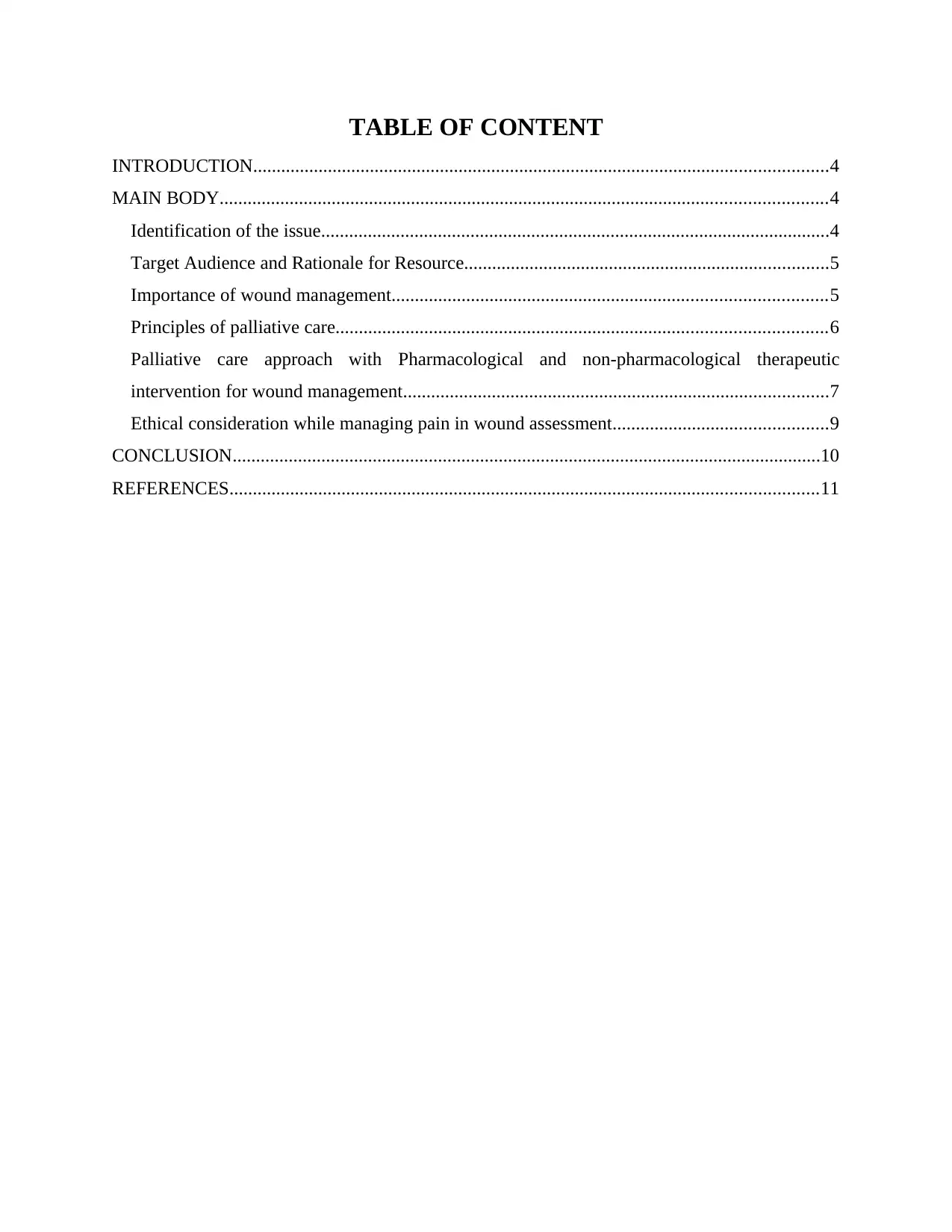
TABLE OF CONTENT
INTRODUCTION...........................................................................................................................4
MAIN BODY..................................................................................................................................4
Identification of the issue.............................................................................................................4
Target Audience and Rationale for Resource..............................................................................5
Importance of wound management.............................................................................................5
Principles of palliative care.........................................................................................................6
Palliative care approach with Pharmacological and non-pharmacological therapeutic
intervention for wound management...........................................................................................7
Ethical consideration while managing pain in wound assessment..............................................9
CONCLUSION..............................................................................................................................10
REFERENCES..............................................................................................................................11
INTRODUCTION...........................................................................................................................4
MAIN BODY..................................................................................................................................4
Identification of the issue.............................................................................................................4
Target Audience and Rationale for Resource..............................................................................5
Importance of wound management.............................................................................................5
Principles of palliative care.........................................................................................................6
Palliative care approach with Pharmacological and non-pharmacological therapeutic
intervention for wound management...........................................................................................7
Ethical consideration while managing pain in wound assessment..............................................9
CONCLUSION..............................................................................................................................10
REFERENCES..............................................................................................................................11
⊘ This is a preview!⊘
Do you want full access?
Subscribe today to unlock all pages.

Trusted by 1+ million students worldwide
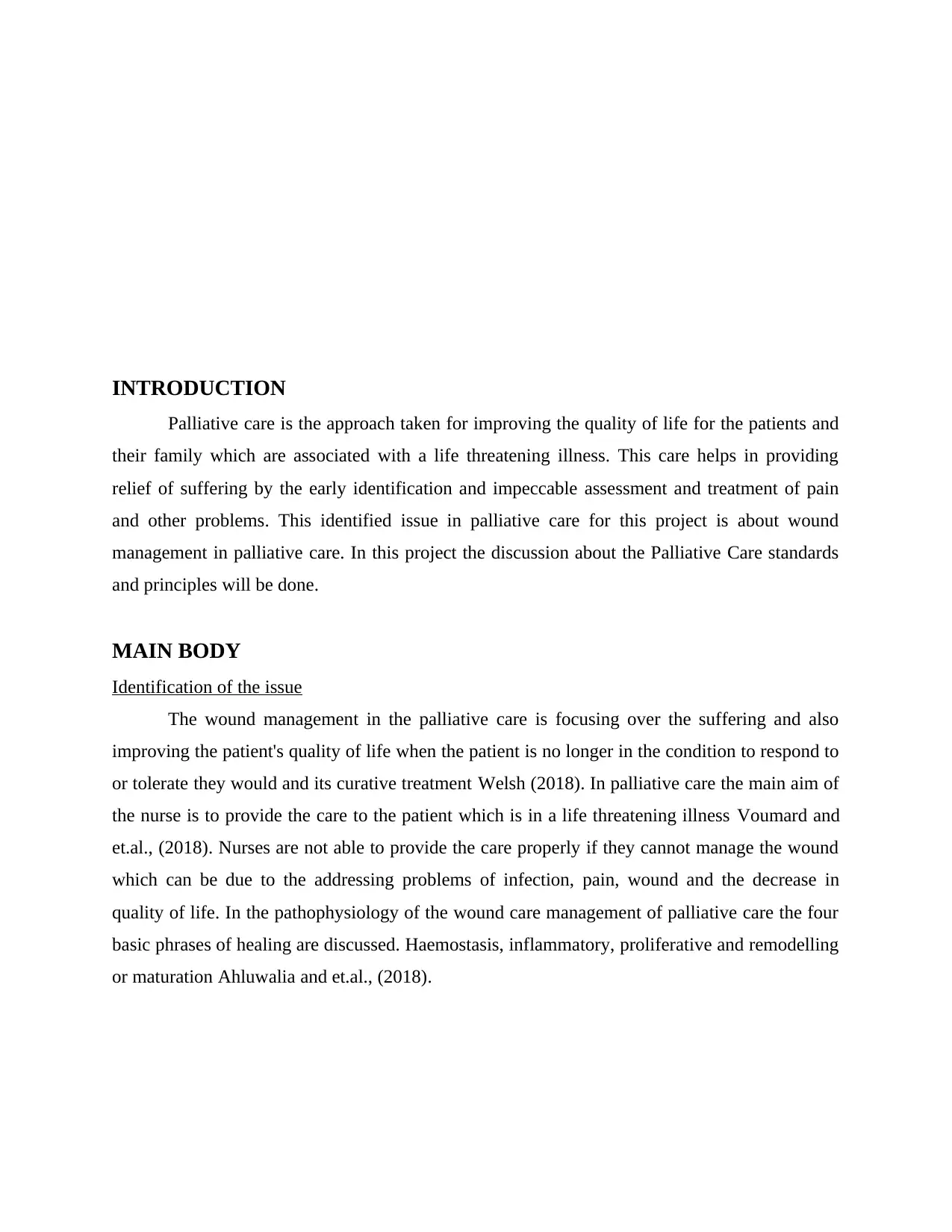
INTRODUCTION
Palliative care is the approach taken for improving the quality of life for the patients and
their family which are associated with a life threatening illness. This care helps in providing
relief of suffering by the early identification and impeccable assessment and treatment of pain
and other problems. This identified issue in palliative care for this project is about wound
management in palliative care. In this project the discussion about the Palliative Care standards
and principles will be done.
MAIN BODY
Identification of the issue
The wound management in the palliative care is focusing over the suffering and also
improving the patient's quality of life when the patient is no longer in the condition to respond to
or tolerate they would and its curative treatment Welsh (2018). In palliative care the main aim of
the nurse is to provide the care to the patient which is in a life threatening illness Voumard and
et.al., (2018). Nurses are not able to provide the care properly if they cannot manage the wound
which can be due to the addressing problems of infection, pain, wound and the decrease in
quality of life. In the pathophysiology of the wound care management of palliative care the four
basic phrases of healing are discussed. Haemostasis, inflammatory, proliferative and remodelling
or maturation Ahluwalia and et.al., (2018).
Palliative care is the approach taken for improving the quality of life for the patients and
their family which are associated with a life threatening illness. This care helps in providing
relief of suffering by the early identification and impeccable assessment and treatment of pain
and other problems. This identified issue in palliative care for this project is about wound
management in palliative care. In this project the discussion about the Palliative Care standards
and principles will be done.
MAIN BODY
Identification of the issue
The wound management in the palliative care is focusing over the suffering and also
improving the patient's quality of life when the patient is no longer in the condition to respond to
or tolerate they would and its curative treatment Welsh (2018). In palliative care the main aim of
the nurse is to provide the care to the patient which is in a life threatening illness Voumard and
et.al., (2018). Nurses are not able to provide the care properly if they cannot manage the wound
which can be due to the addressing problems of infection, pain, wound and the decrease in
quality of life. In the pathophysiology of the wound care management of palliative care the four
basic phrases of healing are discussed. Haemostasis, inflammatory, proliferative and remodelling
or maturation Ahluwalia and et.al., (2018).
Paraphrase This Document
Need a fresh take? Get an instant paraphrase of this document with our AI Paraphraser
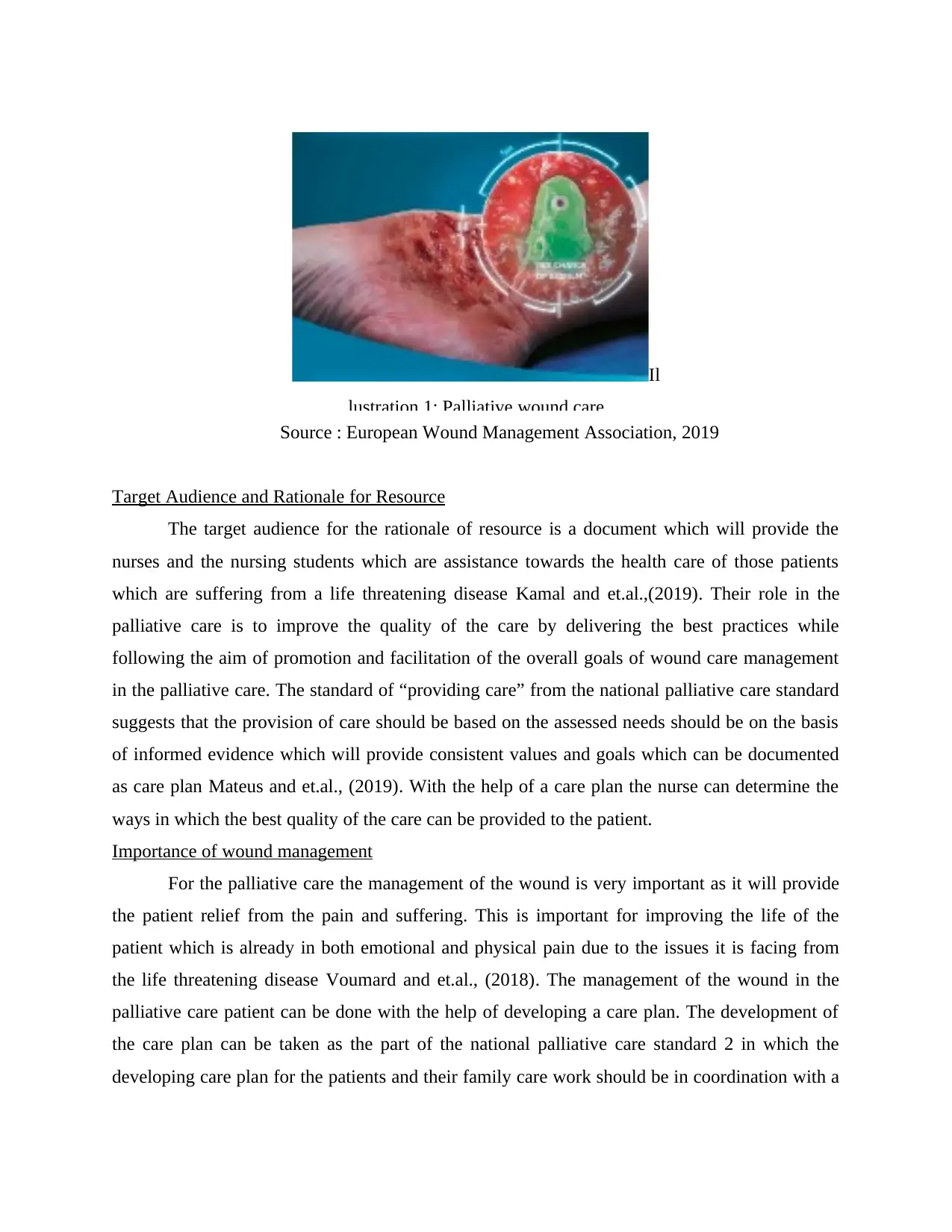
Source : European Wound Management Association, 2019
Target Audience and Rationale for Resource
The target audience for the rationale of resource is a document which will provide the
nurses and the nursing students which are assistance towards the health care of those patients
which are suffering from a life threatening disease Kamal and et.al.,(2019). Their role in the
palliative care is to improve the quality of the care by delivering the best practices while
following the aim of promotion and facilitation of the overall goals of wound care management
in the palliative care. The standard of “providing care” from the national palliative care standard
suggests that the provision of care should be based on the assessed needs should be on the basis
of informed evidence which will provide consistent values and goals which can be documented
as care plan Mateus and et.al., (2019). With the help of a care plan the nurse can determine the
ways in which the best quality of the care can be provided to the patient.
Importance of wound management
For the palliative care the management of the wound is very important as it will provide
the patient relief from the pain and suffering. This is important for improving the life of the
patient which is already in both emotional and physical pain due to the issues it is facing from
the life threatening disease Voumard and et.al., (2018). The management of the wound in the
palliative care patient can be done with the help of developing a care plan. The development of
the care plan can be taken as the part of the national palliative care standard 2 in which the
developing care plan for the patients and their family care work should be in coordination with a
Il
lustration 1: Palliative wound care
Target Audience and Rationale for Resource
The target audience for the rationale of resource is a document which will provide the
nurses and the nursing students which are assistance towards the health care of those patients
which are suffering from a life threatening disease Kamal and et.al.,(2019). Their role in the
palliative care is to improve the quality of the care by delivering the best practices while
following the aim of promotion and facilitation of the overall goals of wound care management
in the palliative care. The standard of “providing care” from the national palliative care standard
suggests that the provision of care should be based on the assessed needs should be on the basis
of informed evidence which will provide consistent values and goals which can be documented
as care plan Mateus and et.al., (2019). With the help of a care plan the nurse can determine the
ways in which the best quality of the care can be provided to the patient.
Importance of wound management
For the palliative care the management of the wound is very important as it will provide
the patient relief from the pain and suffering. This is important for improving the life of the
patient which is already in both emotional and physical pain due to the issues it is facing from
the life threatening disease Voumard and et.al., (2018). The management of the wound in the
palliative care patient can be done with the help of developing a care plan. The development of
the care plan can be taken as the part of the national palliative care standard 2 in which the
developing care plan for the patients and their family care work should be in coordination with a
Il
lustration 1: Palliative wound care
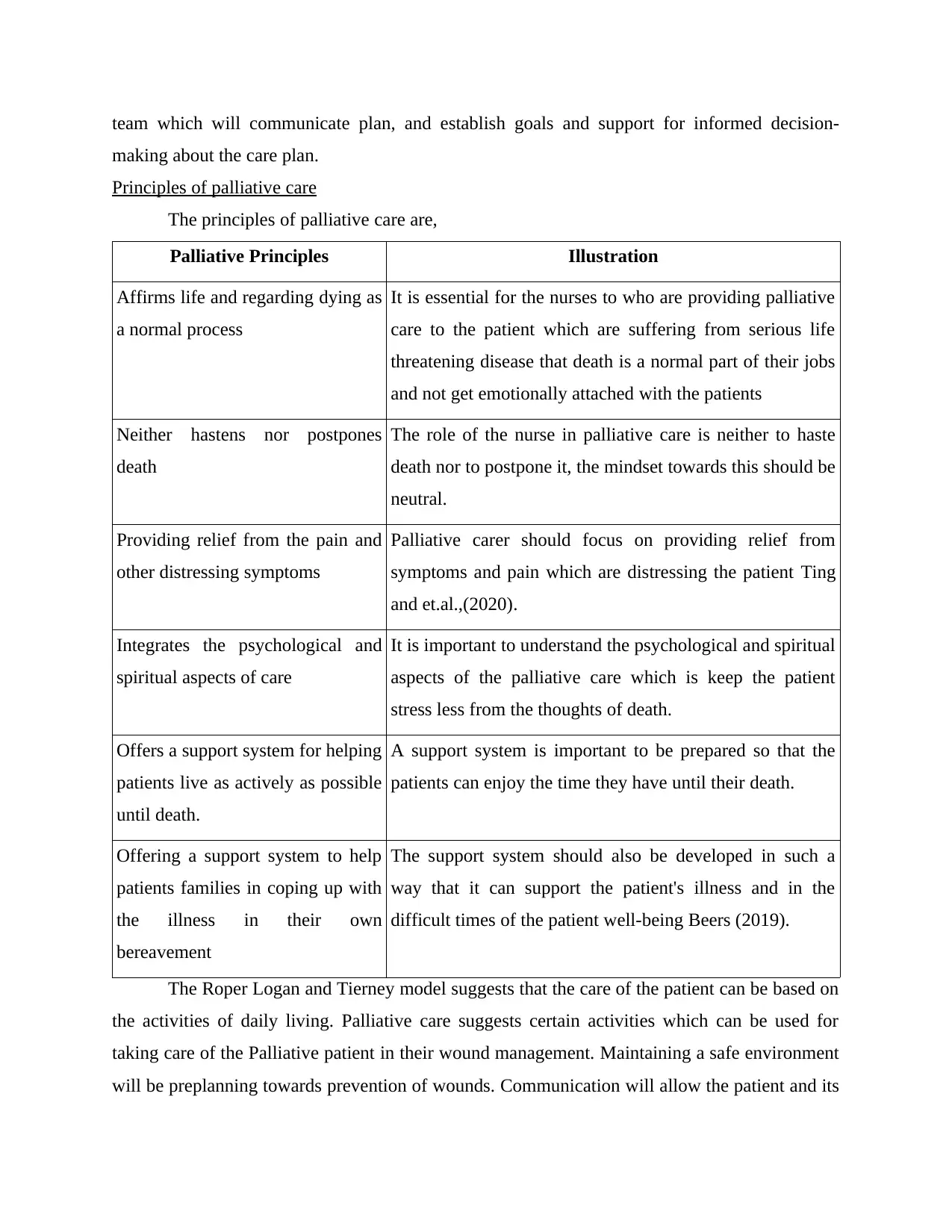
team which will communicate plan, and establish goals and support for informed decision-
making about the care plan.
Principles of palliative care
The principles of palliative care are,
Palliative Principles Illustration
Affirms life and regarding dying as
a normal process
It is essential for the nurses to who are providing palliative
care to the patient which are suffering from serious life
threatening disease that death is a normal part of their jobs
and not get emotionally attached with the patients
Neither hastens nor postpones
death
The role of the nurse in palliative care is neither to haste
death nor to postpone it, the mindset towards this should be
neutral.
Providing relief from the pain and
other distressing symptoms
Palliative carer should focus on providing relief from
symptoms and pain which are distressing the patient Ting
and et.al.,(2020).
Integrates the psychological and
spiritual aspects of care
It is important to understand the psychological and spiritual
aspects of the palliative care which is keep the patient
stress less from the thoughts of death.
Offers a support system for helping
patients live as actively as possible
until death.
A support system is important to be prepared so that the
patients can enjoy the time they have until their death.
Offering a support system to help
patients families in coping up with
the illness in their own
bereavement
The support system should also be developed in such a
way that it can support the patient's illness and in the
difficult times of the patient well-being Beers (2019).
The Roper Logan and Tierney model suggests that the care of the patient can be based on
the activities of daily living. Palliative care suggests certain activities which can be used for
taking care of the Palliative patient in their wound management. Maintaining a safe environment
will be preplanning towards prevention of wounds. Communication will allow the patient and its
making about the care plan.
Principles of palliative care
The principles of palliative care are,
Palliative Principles Illustration
Affirms life and regarding dying as
a normal process
It is essential for the nurses to who are providing palliative
care to the patient which are suffering from serious life
threatening disease that death is a normal part of their jobs
and not get emotionally attached with the patients
Neither hastens nor postpones
death
The role of the nurse in palliative care is neither to haste
death nor to postpone it, the mindset towards this should be
neutral.
Providing relief from the pain and
other distressing symptoms
Palliative carer should focus on providing relief from
symptoms and pain which are distressing the patient Ting
and et.al.,(2020).
Integrates the psychological and
spiritual aspects of care
It is important to understand the psychological and spiritual
aspects of the palliative care which is keep the patient
stress less from the thoughts of death.
Offers a support system for helping
patients live as actively as possible
until death.
A support system is important to be prepared so that the
patients can enjoy the time they have until their death.
Offering a support system to help
patients families in coping up with
the illness in their own
bereavement
The support system should also be developed in such a
way that it can support the patient's illness and in the
difficult times of the patient well-being Beers (2019).
The Roper Logan and Tierney model suggests that the care of the patient can be based on
the activities of daily living. Palliative care suggests certain activities which can be used for
taking care of the Palliative patient in their wound management. Maintaining a safe environment
will be preplanning towards prevention of wounds. Communication will allow the patient and its
⊘ This is a preview!⊘
Do you want full access?
Subscribe today to unlock all pages.

Trusted by 1+ million students worldwide
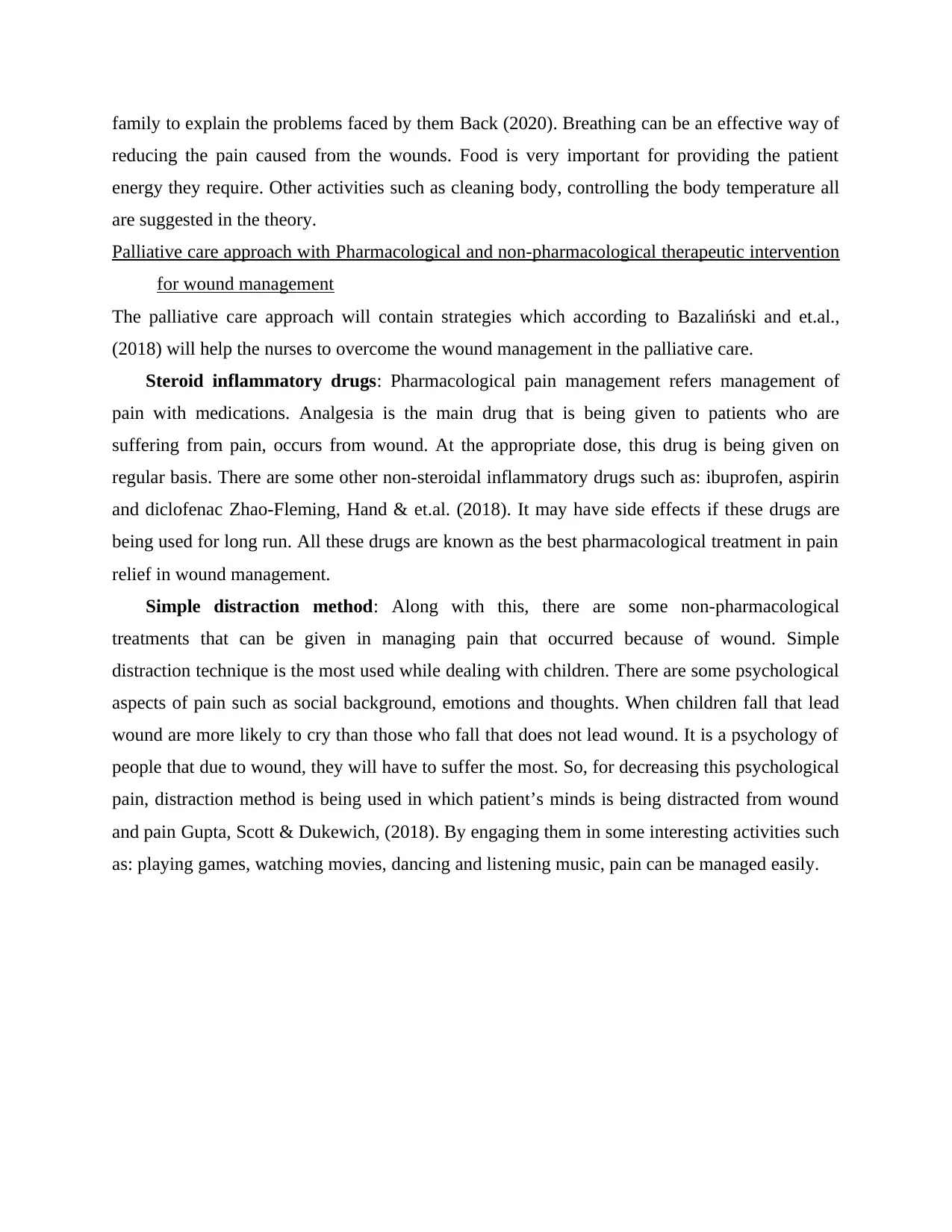
family to explain the problems faced by them Back (2020). Breathing can be an effective way of
reducing the pain caused from the wounds. Food is very important for providing the patient
energy they require. Other activities such as cleaning body, controlling the body temperature all
are suggested in the theory.
Palliative care approach with Pharmacological and non-pharmacological therapeutic intervention
for wound management
The palliative care approach will contain strategies which according to Bazaliński and et.al.,
(2018) will help the nurses to overcome the wound management in the palliative care.
Steroid inflammatory drugs: Pharmacological pain management refers management of
pain with medications. Analgesia is the main drug that is being given to patients who are
suffering from pain, occurs from wound. At the appropriate dose, this drug is being given on
regular basis. There are some other non-steroidal inflammatory drugs such as: ibuprofen, aspirin
and diclofenac Zhao-Fleming, Hand & et.al. (2018). It may have side effects if these drugs are
being used for long run. All these drugs are known as the best pharmacological treatment in pain
relief in wound management.
Simple distraction method: Along with this, there are some non-pharmacological
treatments that can be given in managing pain that occurred because of wound. Simple
distraction technique is the most used while dealing with children. There are some psychological
aspects of pain such as social background, emotions and thoughts. When children fall that lead
wound are more likely to cry than those who fall that does not lead wound. It is a psychology of
people that due to wound, they will have to suffer the most. So, for decreasing this psychological
pain, distraction method is being used in which patient’s minds is being distracted from wound
and pain Gupta, Scott & Dukewich, (2018). By engaging them in some interesting activities such
as: playing games, watching movies, dancing and listening music, pain can be managed easily.
reducing the pain caused from the wounds. Food is very important for providing the patient
energy they require. Other activities such as cleaning body, controlling the body temperature all
are suggested in the theory.
Palliative care approach with Pharmacological and non-pharmacological therapeutic intervention
for wound management
The palliative care approach will contain strategies which according to Bazaliński and et.al.,
(2018) will help the nurses to overcome the wound management in the palliative care.
Steroid inflammatory drugs: Pharmacological pain management refers management of
pain with medications. Analgesia is the main drug that is being given to patients who are
suffering from pain, occurs from wound. At the appropriate dose, this drug is being given on
regular basis. There are some other non-steroidal inflammatory drugs such as: ibuprofen, aspirin
and diclofenac Zhao-Fleming, Hand & et.al. (2018). It may have side effects if these drugs are
being used for long run. All these drugs are known as the best pharmacological treatment in pain
relief in wound management.
Simple distraction method: Along with this, there are some non-pharmacological
treatments that can be given in managing pain that occurred because of wound. Simple
distraction technique is the most used while dealing with children. There are some psychological
aspects of pain such as social background, emotions and thoughts. When children fall that lead
wound are more likely to cry than those who fall that does not lead wound. It is a psychology of
people that due to wound, they will have to suffer the most. So, for decreasing this psychological
pain, distraction method is being used in which patient’s minds is being distracted from wound
and pain Gupta, Scott & Dukewich, (2018). By engaging them in some interesting activities such
as: playing games, watching movies, dancing and listening music, pain can be managed easily.
Paraphrase This Document
Need a fresh take? Get an instant paraphrase of this document with our AI Paraphraser
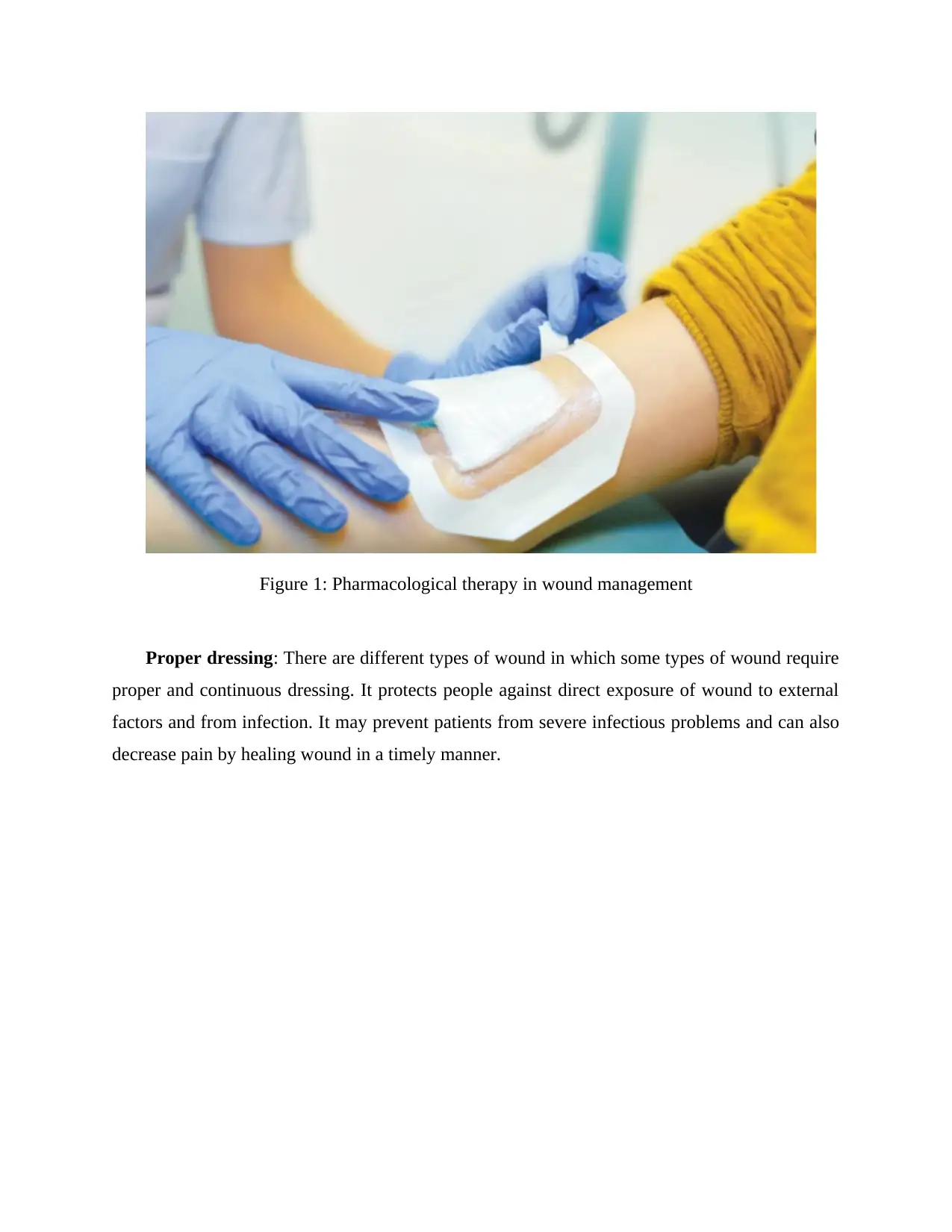
Figure 1: Pharmacological therapy in wound management
Proper dressing: There are different types of wound in which some types of wound require
proper and continuous dressing. It protects people against direct exposure of wound to external
factors and from infection. It may prevent patients from severe infectious problems and can also
decrease pain by healing wound in a timely manner.
Proper dressing: There are different types of wound in which some types of wound require
proper and continuous dressing. It protects people against direct exposure of wound to external
factors and from infection. It may prevent patients from severe infectious problems and can also
decrease pain by healing wound in a timely manner.
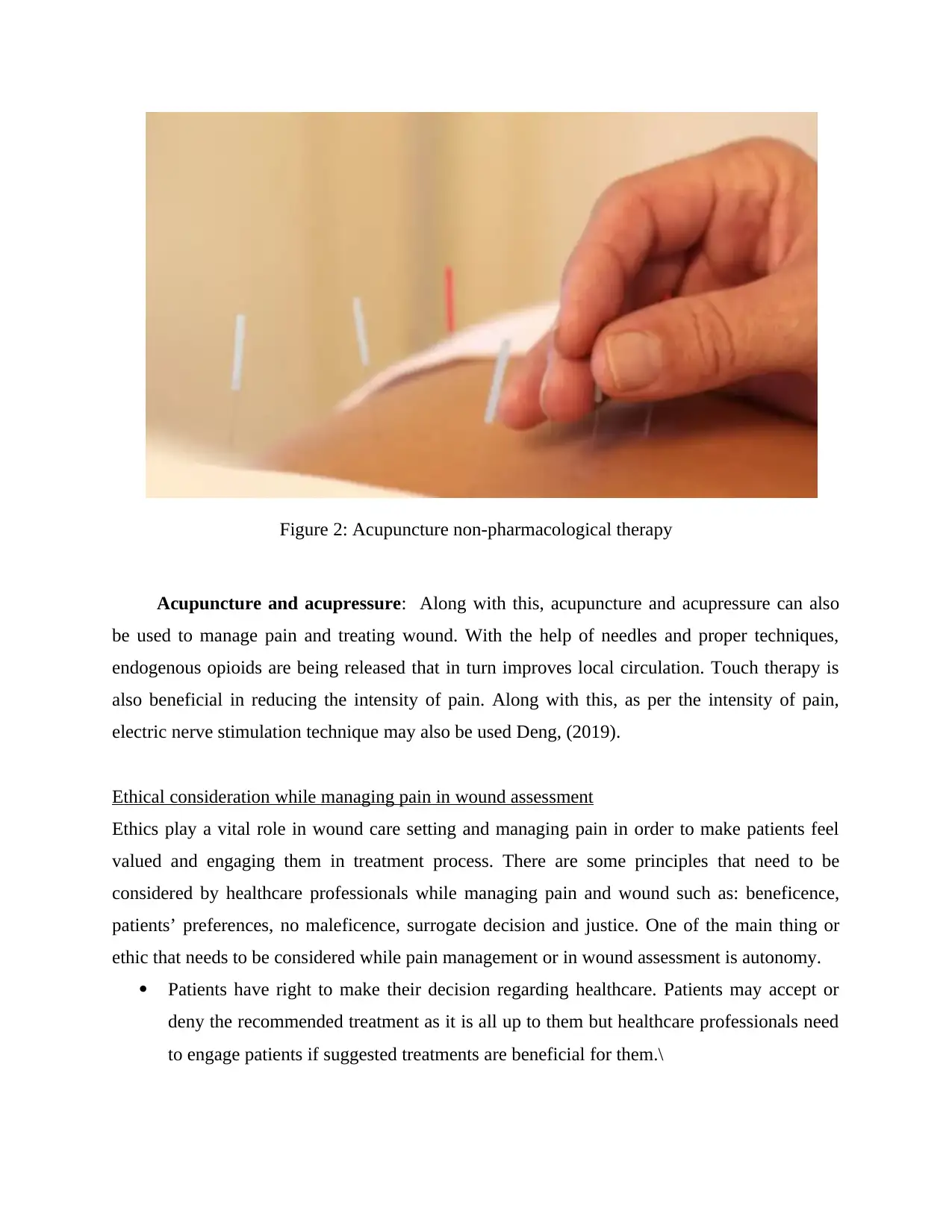
Figure 2: Acupuncture non-pharmacological therapy
Acupuncture and acupressure: Along with this, acupuncture and acupressure can also
be used to manage pain and treating wound. With the help of needles and proper techniques,
endogenous opioids are being released that in turn improves local circulation. Touch therapy is
also beneficial in reducing the intensity of pain. Along with this, as per the intensity of pain,
electric nerve stimulation technique may also be used Deng, (2019).
Ethical consideration while managing pain in wound assessment
Ethics play a vital role in wound care setting and managing pain in order to make patients feel
valued and engaging them in treatment process. There are some principles that need to be
considered by healthcare professionals while managing pain and wound such as: beneficence,
patients’ preferences, no maleficence, surrogate decision and justice. One of the main thing or
ethic that needs to be considered while pain management or in wound assessment is autonomy.
Patients have right to make their decision regarding healthcare. Patients may accept or
deny the recommended treatment as it is all up to them but healthcare professionals need
to engage patients if suggested treatments are beneficial for them.\
Acupuncture and acupressure: Along with this, acupuncture and acupressure can also
be used to manage pain and treating wound. With the help of needles and proper techniques,
endogenous opioids are being released that in turn improves local circulation. Touch therapy is
also beneficial in reducing the intensity of pain. Along with this, as per the intensity of pain,
electric nerve stimulation technique may also be used Deng, (2019).
Ethical consideration while managing pain in wound assessment
Ethics play a vital role in wound care setting and managing pain in order to make patients feel
valued and engaging them in treatment process. There are some principles that need to be
considered by healthcare professionals while managing pain and wound such as: beneficence,
patients’ preferences, no maleficence, surrogate decision and justice. One of the main thing or
ethic that needs to be considered while pain management or in wound assessment is autonomy.
Patients have right to make their decision regarding healthcare. Patients may accept or
deny the recommended treatment as it is all up to them but healthcare professionals need
to engage patients if suggested treatments are beneficial for them.\
⊘ This is a preview!⊘
Do you want full access?
Subscribe today to unlock all pages.

Trusted by 1+ million students worldwide
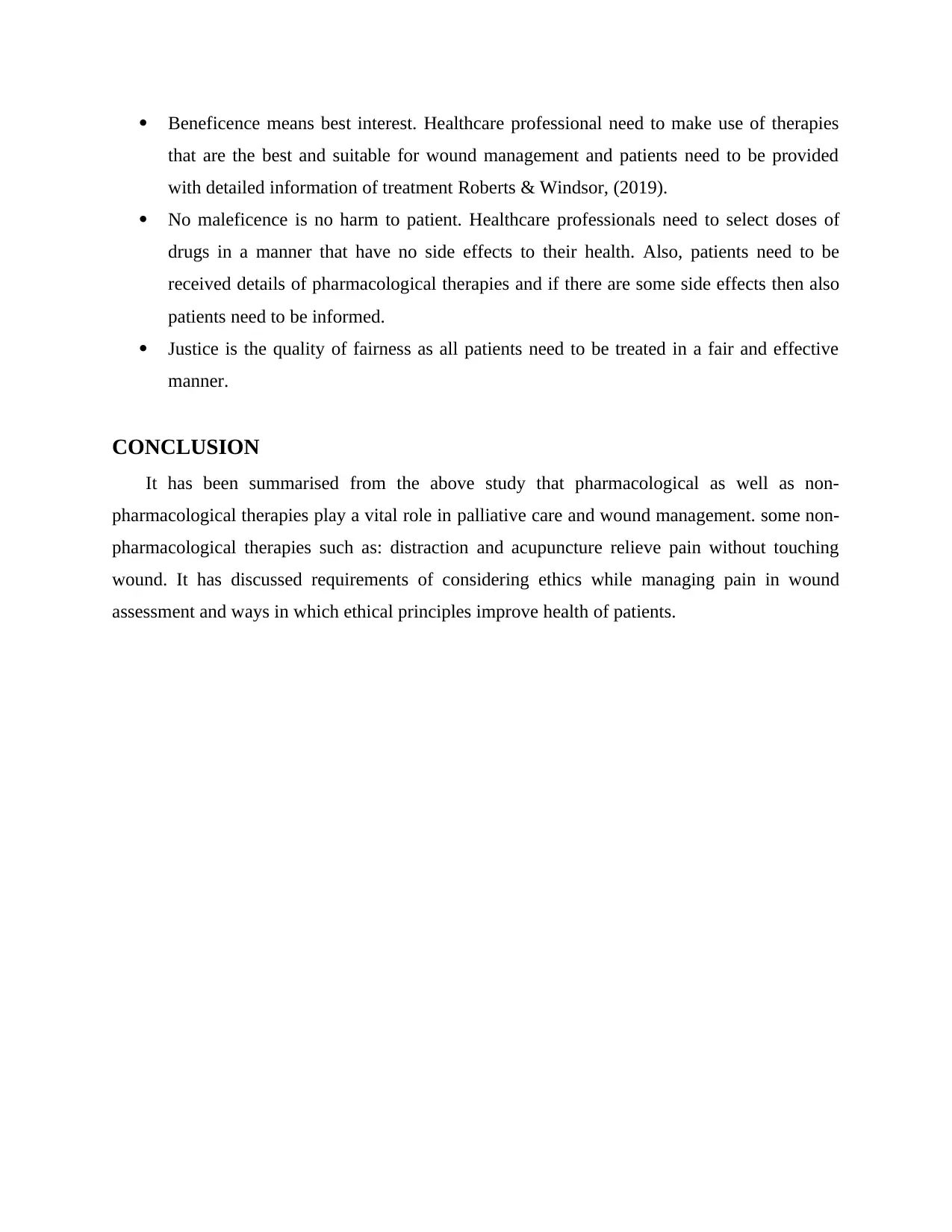
Beneficence means best interest. Healthcare professional need to make use of therapies
that are the best and suitable for wound management and patients need to be provided
with detailed information of treatment Roberts & Windsor, (2019).
No maleficence is no harm to patient. Healthcare professionals need to select doses of
drugs in a manner that have no side effects to their health. Also, patients need to be
received details of pharmacological therapies and if there are some side effects then also
patients need to be informed.
Justice is the quality of fairness as all patients need to be treated in a fair and effective
manner.
CONCLUSION
It has been summarised from the above study that pharmacological as well as non-
pharmacological therapies play a vital role in palliative care and wound management. some non-
pharmacological therapies such as: distraction and acupuncture relieve pain without touching
wound. It has discussed requirements of considering ethics while managing pain in wound
assessment and ways in which ethical principles improve health of patients.
that are the best and suitable for wound management and patients need to be provided
with detailed information of treatment Roberts & Windsor, (2019).
No maleficence is no harm to patient. Healthcare professionals need to select doses of
drugs in a manner that have no side effects to their health. Also, patients need to be
received details of pharmacological therapies and if there are some side effects then also
patients need to be informed.
Justice is the quality of fairness as all patients need to be treated in a fair and effective
manner.
CONCLUSION
It has been summarised from the above study that pharmacological as well as non-
pharmacological therapies play a vital role in palliative care and wound management. some non-
pharmacological therapies such as: distraction and acupuncture relieve pain without touching
wound. It has discussed requirements of considering ethics while managing pain in wound
assessment and ways in which ethical principles improve health of patients.
Paraphrase This Document
Need a fresh take? Get an instant paraphrase of this document with our AI Paraphraser
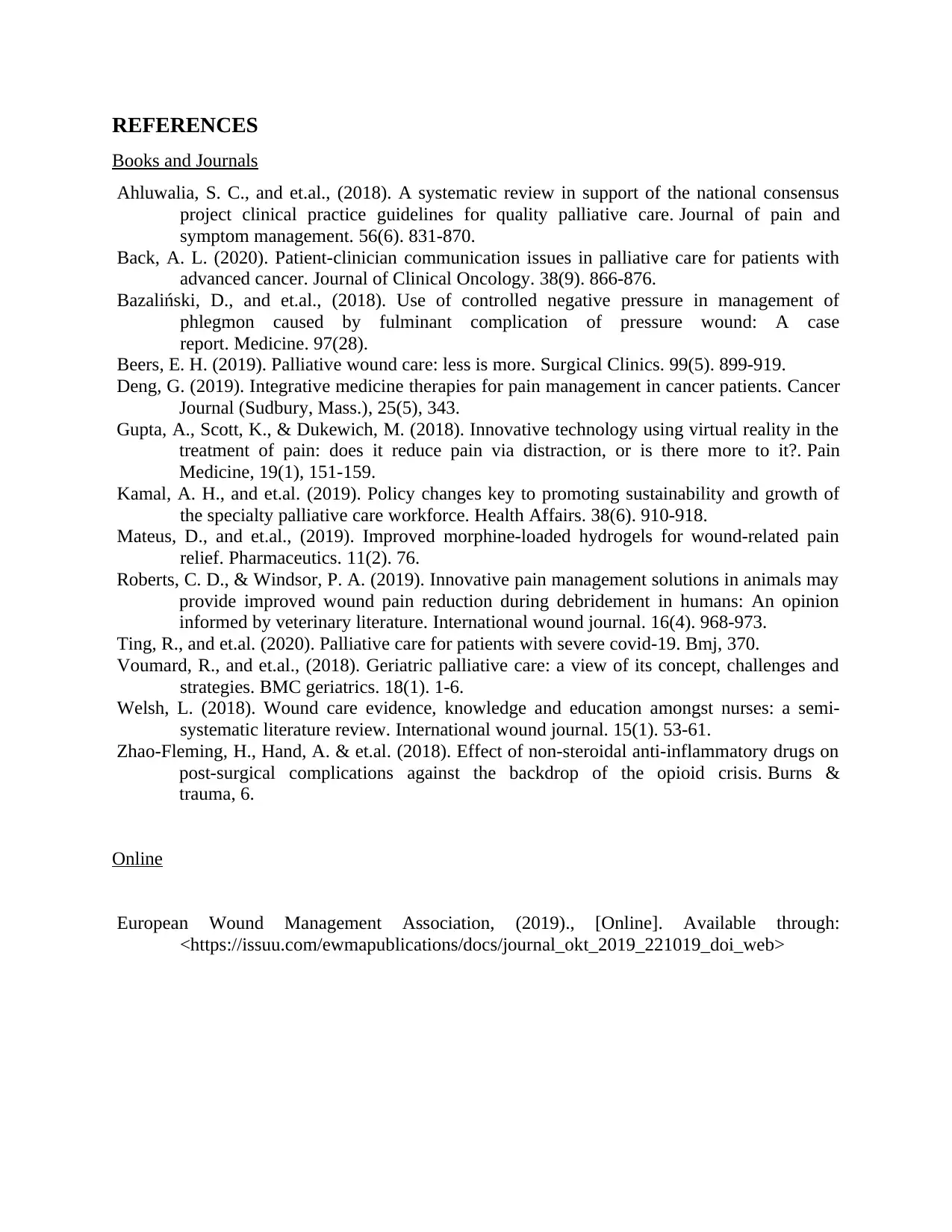
REFERENCES
Books and Journals
Ahluwalia, S. C., and et.al., (2018). A systematic review in support of the national consensus
project clinical practice guidelines for quality palliative care. Journal of pain and
symptom management. 56(6). 831-870.
Back, A. L. (2020). Patient-clinician communication issues in palliative care for patients with
advanced cancer. Journal of Clinical Oncology. 38(9). 866-876.
Bazaliński, D., and et.al., (2018). Use of controlled negative pressure in management of
phlegmon caused by fulminant complication of pressure wound: A case
report. Medicine. 97(28).
Beers, E. H. (2019). Palliative wound care: less is more. Surgical Clinics. 99(5). 899-919.
Deng, G. (2019). Integrative medicine therapies for pain management in cancer patients. Cancer
Journal (Sudbury, Mass.), 25(5), 343.
Gupta, A., Scott, K., & Dukewich, M. (2018). Innovative technology using virtual reality in the
treatment of pain: does it reduce pain via distraction, or is there more to it?. Pain
Medicine, 19(1), 151-159.
Kamal, A. H., and et.al. (2019). Policy changes key to promoting sustainability and growth of
the specialty palliative care workforce. Health Affairs. 38(6). 910-918.
Mateus, D., and et.al., (2019). Improved morphine-loaded hydrogels for wound-related pain
relief. Pharmaceutics. 11(2). 76.
Roberts, C. D., & Windsor, P. A. (2019). Innovative pain management solutions in animals may
provide improved wound pain reduction during debridement in humans: An opinion
informed by veterinary literature. International wound journal. 16(4). 968-973.
Ting, R., and et.al. (2020). Palliative care for patients with severe covid-19. Bmj, 370.
Voumard, R., and et.al., (2018). Geriatric palliative care: a view of its concept, challenges and
strategies. BMC geriatrics. 18(1). 1-6.
Welsh, L. (2018). Wound care evidence, knowledge and education amongst nurses: a semi‐
systematic literature review. International wound journal. 15(1). 53-61.
Zhao-Fleming, H., Hand, A. & et.al. (2018). Effect of non-steroidal anti-inflammatory drugs on
post-surgical complications against the backdrop of the opioid crisis. Burns &
trauma, 6.
Online
European Wound Management Association, (2019)., [Online]. Available through:
<https://issuu.com/ewmapublications/docs/journal_okt_2019_221019_doi_web>
Books and Journals
Ahluwalia, S. C., and et.al., (2018). A systematic review in support of the national consensus
project clinical practice guidelines for quality palliative care. Journal of pain and
symptom management. 56(6). 831-870.
Back, A. L. (2020). Patient-clinician communication issues in palliative care for patients with
advanced cancer. Journal of Clinical Oncology. 38(9). 866-876.
Bazaliński, D., and et.al., (2018). Use of controlled negative pressure in management of
phlegmon caused by fulminant complication of pressure wound: A case
report. Medicine. 97(28).
Beers, E. H. (2019). Palliative wound care: less is more. Surgical Clinics. 99(5). 899-919.
Deng, G. (2019). Integrative medicine therapies for pain management in cancer patients. Cancer
Journal (Sudbury, Mass.), 25(5), 343.
Gupta, A., Scott, K., & Dukewich, M. (2018). Innovative technology using virtual reality in the
treatment of pain: does it reduce pain via distraction, or is there more to it?. Pain
Medicine, 19(1), 151-159.
Kamal, A. H., and et.al. (2019). Policy changes key to promoting sustainability and growth of
the specialty palliative care workforce. Health Affairs. 38(6). 910-918.
Mateus, D., and et.al., (2019). Improved morphine-loaded hydrogels for wound-related pain
relief. Pharmaceutics. 11(2). 76.
Roberts, C. D., & Windsor, P. A. (2019). Innovative pain management solutions in animals may
provide improved wound pain reduction during debridement in humans: An opinion
informed by veterinary literature. International wound journal. 16(4). 968-973.
Ting, R., and et.al. (2020). Palliative care for patients with severe covid-19. Bmj, 370.
Voumard, R., and et.al., (2018). Geriatric palliative care: a view of its concept, challenges and
strategies. BMC geriatrics. 18(1). 1-6.
Welsh, L. (2018). Wound care evidence, knowledge and education amongst nurses: a semi‐
systematic literature review. International wound journal. 15(1). 53-61.
Zhao-Fleming, H., Hand, A. & et.al. (2018). Effect of non-steroidal anti-inflammatory drugs on
post-surgical complications against the backdrop of the opioid crisis. Burns &
trauma, 6.
Online
European Wound Management Association, (2019)., [Online]. Available through:
<https://issuu.com/ewmapublications/docs/journal_okt_2019_221019_doi_web>
1 out of 11
Related Documents
Your All-in-One AI-Powered Toolkit for Academic Success.
+13062052269
info@desklib.com
Available 24*7 on WhatsApp / Email
![[object Object]](/_next/static/media/star-bottom.7253800d.svg)
Unlock your academic potential
Copyright © 2020–2025 A2Z Services. All Rights Reserved. Developed and managed by ZUCOL.





